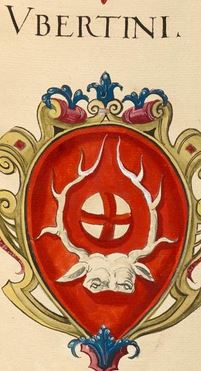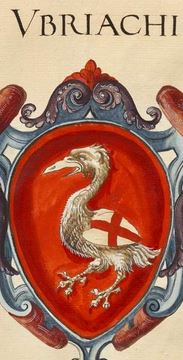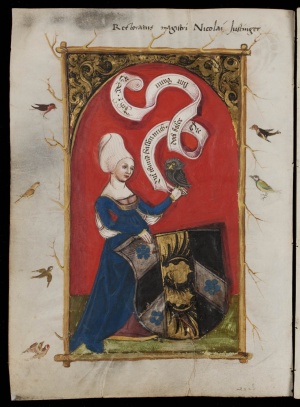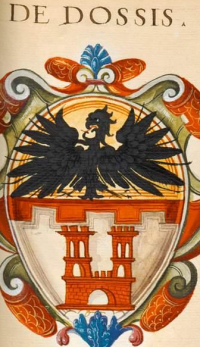Branch Arms Display
WARNING: Do not cite this page as a reference. This page is on this wiki only to make the content "searchable" and easier to find. If you find the information you seek here, go to the original sources as linked below to verify the information and use them for your documentation.
Illustrations[edit | edit source]
Period sources[edit | edit source]
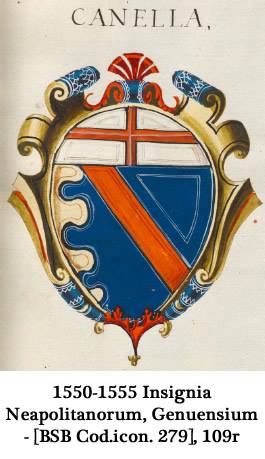
|

|
| BSB 279 Insignia Neapolitanorum, 1550-55, Chief of allegiance. Red on blue. Nebuly tierce? | Standard of Sir Henry Stafford with cross of St. George at the hoist as mark of allegiance. Image from wikimedia commons. |
Chiefs of Allegiance per Mistress Gunnfor silfrahar: There are really two chiefs of allegiance we see: the Guelphs supported the Pope and used a chief of allegiance of the Kingdom of Naples (azure fleury Or a label gules), the Ghibellines supported the Holy Roman Emperor and used a chief of allegiance of the Empire (gules, an eagle sable [actually Or, an eagle sable]). To further signal loyalties, the Guelphs used square crenellations on their architecture, while the Ghibellines used swallowtail crenelations. ANY Italian armory is likely to have these chiefs of allegiance. You will find LOTS in the Insignia series. Oh, and it's perfectly possible to find a chief of Naples on arms with a blue field, just as it is possible to find a chief of Empire on a gold field. i.e., zero contrast. The chief of allegiance isn't really part of the arms, it's a plea "don;t kill me, I'm your ally!" See http://www.vikinganswerlady.com/Stars/Rolls_of_Arms.html
Relevant rules and opinions:[edit | edit source]
Soon to be in the Trimaris Heralds Handbook (as of 3/2015): "The shire banner may be displayed anywhere that there are at least 2 shire members present to identify the groups presence. If a single person is all that is present the shire badge should be utilized."
December 2013: Emma Wreath Emeritus, posted: "I think for best historical analogs for branches without a B&B [baron/baroness], we should look at corporate armory. The City of London, for example, has had its current arms since the 1300s. Wikipedia says its flag (identical to arms) "flies from various buildings in the city such as formal buildings including Guildhall (the seat of power in the city) and Mansion House, the official residence of the Lord Mayor of London (the Lord Mayor has a variant of the flag, defaced with his coat of arms). It can also be seen on sites administered by the City of London Corporation (the governing body of the city) such as the Heathrow Animal Reception Centre atHeathrow Airport and Hampstead Heath. It can also be seen on certain landmarks, such as the bridges maintained by the Bridge House Estates." That's modernly, of course, but still. And yes, London may be considered a bit of an odd fish, but plenty of other cities and towns that were incorporated had their own coats of arms."
January 1998 Daniel de Lincoln said (Jan 1998): "I would use an analogy with non-SCA corporate bodies and suggest that it be used only for official shire events and purposes, by whoever happens to be there. E.g., if there's a demo sponsored by the shire, then the people who show up (maybe including the seneschal, maybe not) should display the arms."
Precedents:[edit | edit source]
July 1980 Cover Letter - branch arms and badges:[edit | edit source]
"The arms of a branch are reserved to the head of the branch. In the case of a kingdom, principality or barony this is the King, Prince or Baron. In all other cases it is the seneschal. Kings, Princes and Barons may bear the arms of their branch upon a shield in battle as if they were their own personal arms, so long as they hold their office and no longer. Seneschals may not do so. All heads of branches may display the banner of the branch to indicate their presence. At any event held in a branch the arms of the branch may be displayed whether or not the head of the branch is present, to indicate that the branch is hosting the event. In grand marches the arms of branches may be carried by groups marching as those branches. Otherwise nobody can display the arms of a branch as if they were personal arms."
"Branches may register one or more badges which are to be useable by groups or individuals belonging to those branches. A province could register a badge to be used by a provincial mercenary unit, such as a shield wall squad. A kingdom could register a badge to be used by all subjects of the kingdom at wars with another kingdom to show their allegiance." [1980 LoAR Cover Letter]
From the Early Days:[edit | edit source]
Arms, Branch[edit | edit source]
The device was judged to be excessively complex [charged primary, secondary in base, and embattled bordure] and poor style to a degree which should not be accepted for group arms which precedent indicates "should set a good example". (LoAR 27 Sep 86, p. 13)
There is a long-standing precedent in Society heraldry which considered charged sails as being equivalent to arms of pretense and therefore forbidden for Society usage: "You may not charge a sail if the resulting sail conflicts with existing arms".... (The passage of the arms of Eisenmarche cited ... in the letter of intent is a special case ...: the arms of the Society, which the Board has specifically stated may be displayed by any group.) (LoAR 28 Dec 86, p. 13)
The Kingdom’s arms are the arms of the king and should be worn only by the king himself and his herald, when speaking as the king’s voice. After some consideration, we have come to the conclusion that it is inappropriate that the arms of a Kingdom should be used as an augmentation, even if the recipient is entitled to bear a coronet on his or her arms. The badge of a Kingdom or a rendition of the arms without the laurel wreath can, however, be used. (LoAR Aug 88, p. 16) http://heraldry.sca.org/precedents/alisoun/AMEA.html#ARMSBRANCH
